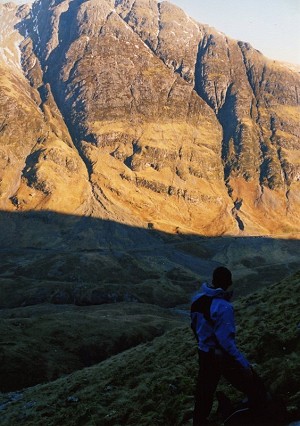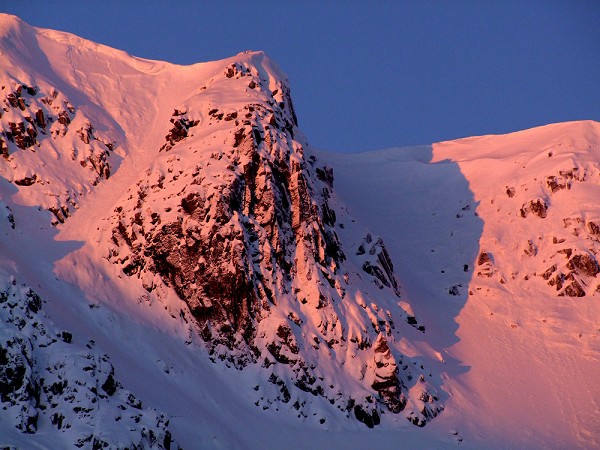
Note: UKClimbing recognises that solo climbing is a dangerous activity. Both on UKClimbing.com and in Rockfax guidebooks, we have a general policy of not overtly crediting solo ascents except where appropriate (eg. deep water soloing). This article has been published because it is an interesting account of the approach of the soloist but in general we do not advocate this approach to climbing and mountaineering.
"A boy clambers barefoot up a tree. He does it for the pure joy of climbing; why doesn't matter. It is exciting. New. There is a bit of danger. The thrill of adventure in going somewhere he has never been."
Royal Robbins
It is, on occasion, both equally intriguing and disconcerting to discover some of the places where blinkered determination can take you. This particular journey began just 10 months before with a solo ascent of the über-classic, Tower Ridge (IV,3), in glorious alpine conditions. My first "proper" winter route. After completing Ben Nevis's most acclaimed ridge, I embarked upon a summer course, climbing classic rock in the central highlands, complemented with a little exploration of my own. And then winter rolled around again.
Raeburn's Route on Stob Coire nan Lochan (SCnL), Glen Coe, resembled the next reasonable step, and on a miserable day, after an even more miserable and bitterly cold night camped beneath the andesite cliffs, I set off up the direct start, taking the pedestal variation (IV,5) to the top. I now had experience, albeit minimal, of Grade IV ground. It was time for a V, "the grade to which most climbers aspire", I had once read. (The statement was directed at roped parties, not soloists).
I didn't know any other climbers, hence the solos, and online forums were only just developing - I certainly wasn't aware of their existence and didn't even own a computer. So I scanned the SMC guides for my information. Focusing on front-end grades due to a primitive understanding of technical difficulties, I chose Crest Route as my V. A modern, snowed-up rock route, it takes an uncompromising line on the steep North Buttress of SCnL.
Rab Anderson's description didn't speak of any hard cruxes or awkward moves. In fact, quite the contrary, with the words "a good introduction" being used in reference to the type of climbing. The objective seemed perfectly logical and was also in a coire with which I was familiar.
Early February and a Category 4 avalanche warning had been issued for the area. Strong gales were whipping up perpetual snow flurries, converging sky and massif, making it almost impossible to discern a horizon. I waded, frequently chest-deep, towards the buttress.
On reaching the base, the painful process of reinstating feeling to my frost-nipped fingers got underway. The scene was ludicrous. I hadn't even started the route but as spindrift relentlessly swept the rock, I knew that nothing was going to happen here today, let alone a solo at the limit of my imagination.

I take a drink of water and look back down the tightly-hemmed valley to civilisation and across to the amber and bronze slopes of the Aonach Eagach, soft in the morning light. Not for superstitious reasons, I somehow sense the need to reassure myself that I will gaze upon this land again, that whatever the outcome of the climb, this is a life that will not desert me, nor I it.
Under a steel blue sky, the buttresses of SCnL (Summit, South, Central, North and Pinnacle) stand sentinel, streaked in brilliant white ice. Foreboding yet alluring, they enclose a high mountain cirque, lending balance and grace to an otherwise harsh environment. From well-trodden classics such as the deeply-cut Twisting Gully (III,4) to seldom-repeated testpieces like The Duel (IX,9), a broad range of struggles are on offer here, packaged into a compact arena.
A number of teams are gearing up or already established on climbs. Crest Route is free. I dig out my helmet and crampons, and release my axes from the 'sac. I hurry to a spot beneath the route and, craning my neck, study the line.
“Teetering on my front points 300 feet above the coire floor, I find myself staring at a steep, blank wall split by a single crack.”
Initial ground is covered positively with solid placements for both feet and tools. It is stimulating to finally be in motion, to be doing rather than dreaming. Bridging across to a spike and gaining the crest of the buttress from which the route derives its name, it is obvious that from now on I won't be able to downclimb should things not go according to plan.
And therein lies the paradox. High-standard ropeless soloing allows a purity of movement but demands restless concentration and is often inescapable. The resilient and bold Polish climber, Voytek Kurtyka, would refer to "a state of nakedness - lightweight and vulnerable but confident. A state of self-belief usually preceded by long periods of doubt and fear." On the whole, it's a combination that I'm comfortable with.
As the exposed and sustained nature of the climbing becomes more pronounced, abseil tat appears. Piece after piece, they tell stories of intimidation, encroaching darkness and insurmountable obstacles. These are not good signs for the soloist. However, with every progression made, trust in my ability grows, as does the amount of fresh air snapping at my heels.
Teetering on my front points 300 feet above the coire floor, I find myself staring at a steep, blank wall split by a single crack. This is the line of the first roped ascent although most teams (understandably) bypass it for an easier variation finish as standard. I slot a pick in the crack and lean to the left, trying to see around the wall, brushing it with my gloved hand, feeling for a weakness. Nothing. I repeat on the right side with similar results. There is nowhere else for me to go but upwards.
A small shelf at chest height provides enough room for my right fingers. I readjust my left pick in the crack and torque the shaft - it feels secure yet tenuous. I move up until I'm in a contorted position, ensuring I don't alter the pick angle but alert to the exertion in my right arm and wondering what I do next. I lower myself back onto my tip-toes and grimace. I try again and lower again. Half an hour passes before I finally commit to the technical 7 sequence.
Pulling up once more, I tentatively manoeuvre away my fingers and replace with a knee. I now have a free right arm and flick my tool into my palm, reach up and try to hook the ledge above the wall. I am losing strength. The pick bangs off the rock. The seriousness of the situation could not be more apparent.
I cannot reverse my position safely now, I have to hook the ledge this time. I have to. I am at full stretch as I swing again, the pick clears the top of the wall and bites firmly. Unable to test the placement, I pull as hard as I can, managing to settle my right crampon points onto the crucial shelf where my knee had rested. I remove my left pick from the crack and stand up. I see sanctuary above.
An encounter of great personal magnitude can bestow a wealth of knowledge on an individual if they are receptive to it. I climbed the route primarily for validation and as a measure of self-worth. Held hostage by my ambitions, I had gotten away with it but failed to learn all that I could - essentially, climbing has no value if this occurs. It was somewhat inevitable then, that more unforgiving experiences were required before lessons were distilled, before contempt for "easy" routes became respect.
Ultimately, I emerged from this pivotal, formative period reborn. I was, once again, the boy in the parable at the beginning of this tale, climbing for climbing's sake. The beautiful simplicity of our pursuit had returned.
- Low Winter Sun 10 Dec, 2009
- The Tyranny of Success 10 Dec, 2008















Comments